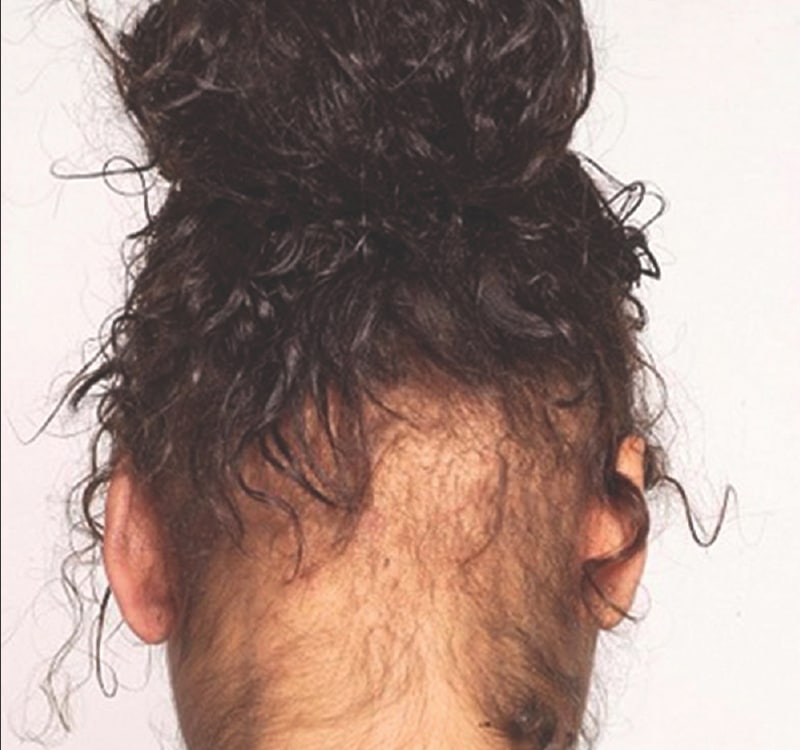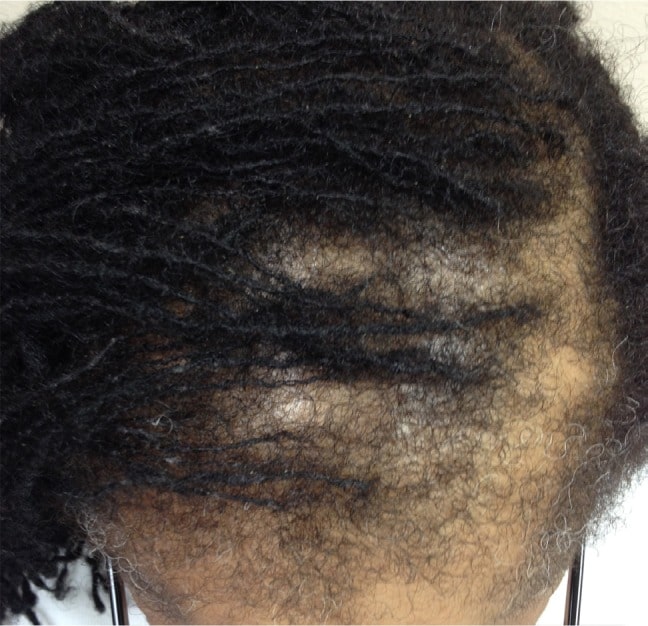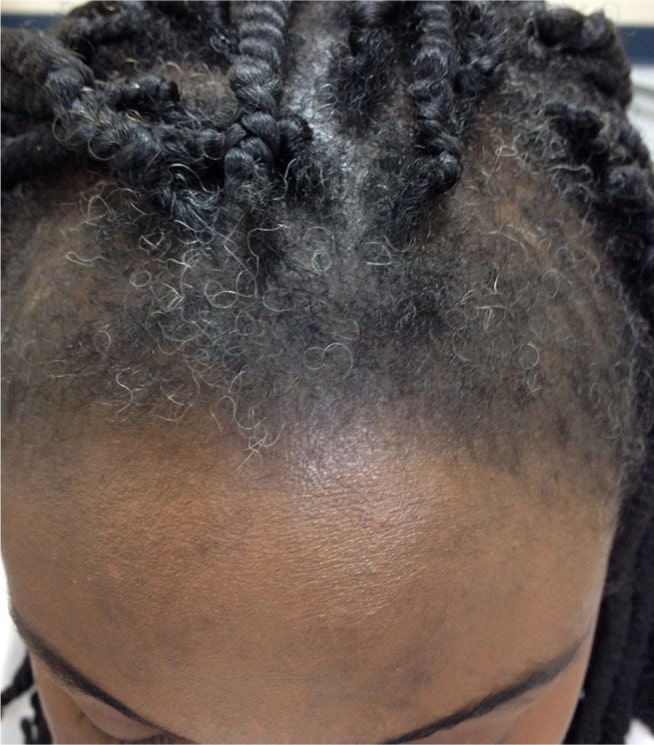Traction Alopecia: How to Reverse It? Causes and Treatment
Many people style their hair not only to look presentable but also as a cornerstone of their identity and self-esteem. Ironically, some of the hairstyles we choose may damage our hair and scalp!
One report indeed confirms that some hairstyles can damage your hair follicles, leading to a gradual loss of hair – traction alopecia, also known as tension alopecia.
What is traction alopecia?
Traction alopecia is a loss of hair caused by repeated pulling tension or stress on the hair and its follicles.
You probably have heard someone talking about their hair being “snatched” at the edges. It is something mysterious that they can’t explain. That mysterious cause is most likely traction alopecia. However, traction alopecia doesn’t only take hold of your hairline, it may affect other parts of your scalp as well.
Photographs of scalps affected by traction alopecia:
It is estimated that traction alopecia affects roughly one-third of women of African descent. This makes it the leading type of hair loss among them. It probably is the reason behind the lifted baby hairs you see on your friend’s head.
It is however important to note that traction alopecia can happen to anyone regardless of their ethnicity or age. For example, it is quite common among Caucasian gymnasts and ballet dancers as well as other sports professionals who have to wear tight ponytails or buns for lengthy durations.
Older people of all races are also more likely to experience traction hair loss because their hair follicles weaken naturally as they age.
Interestingly, even pets can experience traction alopecia. If, for instance, you leave hair clips in a dog’s fur for far too long or if you let your furry four-legged pal’s fur form dreadlocks, the resulting stress on the hair might strain the follicles so much that the dog starts to lose hair gradually.
Usual causes of traction alopecia
Traction alopecia is essentially hair loss due to traction, i.e., hair loss caused by hair pulling, ouch! In most cases, tightly pulled hairstyles are usually the culprit behind this type of hair loss.
Ask any African woman, and they’ll probably relate to one or two harrowing episodes where they sat at the salon silently gnashing their teeth as their rebelliously beautiful hair was pulled back into tight cornrows or braids!
Even after enduring all that torture, the braids came out a few weeks later- much to the lady’s chagrin- and so does their hairline! That’s probably when they first came face to face with the ugly head of traction alopecia!
Not every woman can relate to these salon horrors of course, but that doesn’t mean they are safe from traction alopecia. This type of hair loss is most often self-inflicted and may be caused by:
Essentially what these hairstyling processes do is create traction. When this happens repeatedly, and for a prolonged duration, inflammation develops around the hair root, and the hair shaft becomes loosened in its follicle. Eventually, the hair may end up falling out in clumps!
Signs of traction alopecia
The hair loss is gradual, and the damage is usually cumulative. It may take some time before the symptoms become evident. Nevertheless, the following signs may be indicative of traction alopecia:
Initially, traction alopecia doesn’t cause scarring. However as time goes by, and the traction to the hair is sustained for a long time, one may begin to see areas of shiny, scarred skin.
Traction alopecia symptoms may vary from person to person. An individual’s hair care practices primarily determine them. The condition most commonly affects the sides (temporal) and front (frontal) of the scalp. This has led to the description of the fringe sign as a useful clinical marker of traction alopecia.
The fringe sign is an observation that in people with traction alopecia, some hairs are retained along the temporal or frontal rims of their hairline.
A dermatologist or a health professional may confirm or do further analysis of suspected traction alopecia through trichoscopy and histological analysis.
Can traction alopecia be reversed?
Anything that pulls on your hair may damage your root hairs, thereby causing traction alopecia. The damage occurs slowly and in phases. So if caught early, it can be stopped, and any hair loss or thinning reversed.
Usually, if a hairstyle is too tight, little pimples and pain appear first. This is called traction folliculitis, and it is a result of tension on the hair causing inflammation within the follicles.
Hair thinning and falling off come next, and these are the hallmark of traction alopecia. Any damage that occurs during these phases can be reversed.
However, if traction alopecia is left untreated, and the follicle is put under constant tension, irreversible damage occurs. The hair follicle will get inflamed, and hair will stop regrowing, eventually leading to permanent scarring and hair loss!
Treatment options
Giving your hair a break from any style that might cause traction is the primary treatment for traction alopecia. You could, for example, try wearing it up or down, or alternating between the two. If you absolutely must pull it back, go for a style that’s low and loose.
You should avoid exposing the affected parts of your scalp and hair to excessive heat and chemicals.
If your hair is too long, you should consider cutting it short.
If you’ve lost hair, you could apply topical minoxidil, to help regrow hair to fill in the sparse areas.
Medical and surgical management
One of the FDA-approved options for hair loss treatment is minoxidil. It’s effective at stopping hair loss as well as enhancing new hair growth.
Minoxidil is available as an over-the-counter topical solution, usually varying in concentration from 2%, up to the high strength minoxidil solutions of 10 to 15 %. The solution works by dilating the small blood vessels underlying the area of the skin on which it’s applied.
It also enhances cell proliferation and regulates the activity of immune cells in the hair follicle. The net effect is usually increased hair growth, which becomes noticeable after approximately four months.
Typically, minoxidil is applied to the part of the scalp affected by traction hair loss once or twice daily. It’s worth noticing that women are usually advised to use 2% minoxidil, which is a lower concentration compared to the usual 5% for men.
Traction alopecia recovery time is usually long, especially if the condition is advanced. Therefore, one may be required to use minoxidil for at least six months, and if it’s effective, minoxidil application will have to be continued long term.
However, even though one doesn’t necessarily need a doctor’s prescription to buy minoxidil, it is prudent to first seek primary care from a health specialist or dermatologist before trying out any hair loss treatment.
This is mainly because there might be other underlying medical conditions that might be contributing to hair loss.
Clinically, Minoxidil treatment may be combined with several other traction alopecia remedies including:
Generally, hair transplantation (follicular unit transplant or extraction) is only considered for traction alopecia when it is too late and the hair loss is permanent.
How to prevent from traction alopecia in the future?
Braids, extensions, dreadlocks, ponytails, and similar hairstyles aren’t the direct cause of traction hair loss. All these styles can be worn safely and not cause hair loss.
The problem only comes if the hairstyle is so tight that it puts tension on your hair follicles. When that happens, the follicles get inflamed, and your hair breaks.
Now that you know about traction alopecia, you don’t have to go cold turkey on your favorite hairstyle to avoid losing hair. Make small, consistent hair-friendly changes.
If for instance, you have extensions and also use hair relaxers, you could space out your chemical treatments for about three months and eventually go natural.
The following tips will also work well to keep traction alopecia away:
Bottom line
In its early stages, traction alopecia causes non-scarring hair loss, which is completely reversible. If discovered early, you have the potential to get your hair back if you make positive styling changes and seek proper treatment.
However, if the hair loss is too far gone and irreversible, several hair replacement therapies may be used to help get your hair back. Either way, it’s always helpful to talk to a dermatologist or a qualified health professional if you suspect traction alopecia is creeping up on you.


